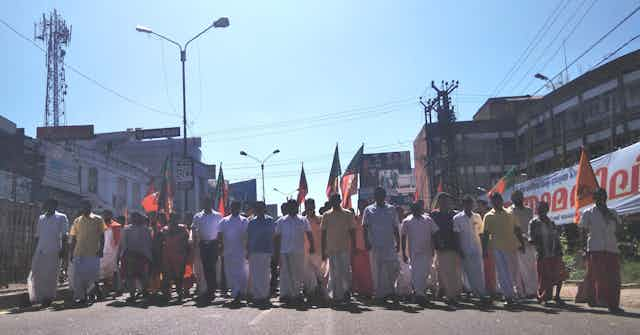Anyone traveling in November and December by train in the southern districts of Kerala, the southwestern state of India, would see crowded compartments filled with men, children and older women clad in black clothes, headed toward Sabarimala temple, chanting “Ayyappo Saranamayyappo” (“Ayyappa, you are our solace”) praising Ayyappan, the deity in Sabarimala temple, while also sharing food and enjoying themselves. But this past year, the period was marked with sloganeering, acrimonious protests and bursts of violence in Kerala’s public space.
Protests and counter-protests
On September 28, 2018, the much-debated Supreme Court order granted women of child-bearing age the right to enter the temple, from which they were traditionally excluded. This restriction was based on the Brahmanic Hindu religious doctrine of purity, which considers menstruating women and Dalit – a political term used by the formerly untouchable castes of India – to be impure.
Until January 2, 2019, many women’s attempts to enter the temple were thwarted by protestors largely mobilised under the Hindu nationalist political groups, including the ruling Bharathiya Janata Party (BJP), at the centre.
The state’s Left Democratic Front (LDF) government supported enforcement of the Supreme Court order and organised counter-mobilisation against the right-wing Hindu protestors.
Convergence of minority groups
A range of groups, including feminists, anti-caste activists (caste is a form of graded hierarchy ensued through birth and endogamy as per Hindu Brahmanical faith in India), and Dalit feminists, also demanded protection of the constitutional right of women of all ages to enter the temple.
These seemingly disparate groups used shared issue of temple entry as a symbol in the struggle against the Brahmanical supremacy that excluded and oppressed them. Throughout Indian history, Dalits have fought to gain access to public spaces including roads and temples. Although Dalits were granted the right to enter temples after the 1925 Vaikom Satyagraha, even today there are many stories of Dalits being attacked for exercising such rights.
Notions of impurity around menstruation are still prevalent in many forms in Indian society and the Supreme Court’s Sabarimala verdict created an opportunity to break with this age-old tradition, triggering charged protests and counter-protests.
A wall to claim “renaissance values”
Right-wing Hindu forces protested and organised religiously charged events in an attempt to tap into the underlying sense of tradition that still has its grips firmly in the otherwise “progressive” state.
For example, Sabarimala Karma Samithi, a committee formed to protect the age-old traditions and customs of Sabarimala, backed by the BJP, organised an Ayyappa Jyothi (Ayyappa’s Holy Light) on December 26, 2018. Reports claim that hundreds of thousands of devotees participated, praying to Ayyappa to protect tradition in these troubling times. At least in this context, the tradition is synonymous with the Brahmanical Hindu religion’s conservative conception of purity.
Extensive media coverage of the event showed images of women clad in traditional attire holding jyothi (light) in their hands. In response, on the New Year’s Eve the left-wing state government mobilised women to form a 640km long wall to reclaim women’s place in society through “renaissance values”, a concept yet to be defined.

With a turnout of five million women, it was a successful demonstration against restrictive traditions that perpetuate injustice.
However, there are contradictory reports about the mobilisation efforts used by the LDF, including threats of losing work for women in self-help group initiatives. There are also debates about what renaissance means in this context as well as why the government wanted to masquerade its mobilisation for women’s constitutional right to enter the temple with ambiguous terms.
Polarised media coverage
The media images and reportage of these events illustrate a story of how media becomes an implicit partner in fostering the existing caste and gender stereotypes.
In the coverage of Ayyappa Jyothi, the preference for images of certain kinds of garments and bodies of women synchronises with the stereotype of the demure, devoted savarna (upper-caste) woman).

Scholars including Jenny Rowena assert that Brahmanical patriarchal protection envisioned savarna femininity based on notions of “chastity, virginity and docile femininity”, and the visuals of the event seem to reproduce this Brahmanical conception. What is visible here through these images is in the place of many other Dalit, lower-caste, transgender women and bodies, whose absence is made possible through a history of stigmatisation in the name of caste and sexuality.
While the “women’s wall” organised by the LDF government was interpreted as an event of importance that gave visibility and voices to women and activists the images in media show them in assertive poses – pledging, sloganeering and speaking. From the demure woman devotee to the assertive woman, media images seem to replicate the extreme polarisation that the right and the left tread carefully as they aim at the vote banks despite their ideological differences.
This attempt to capitalise on the events is evident in some of the report titles, including “Sabarimala showdown”, depicting a woman activist and devotee who was stopped at the airport of Kochi by crowds chanting after she made it clear she would seek to enter the temple as per the court order.
What gets lost in this heightened sense of dramatisation are the many nuanced discussions required to disrupt the complex networks of gender oppression that are woven through caste and religion in Kerala.
Nonetheless, the entry of two women, including a Dalit woman – Bindu and Kanakadurga – into the temple in the early hours of January 2, 2019, stands as a symbolic historical corrector that marks a small victory reminding one of the colossal efforts ahead to take many such remarkable first steps.

